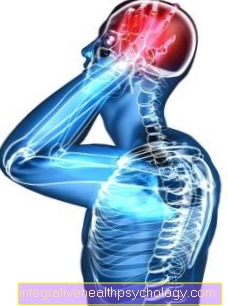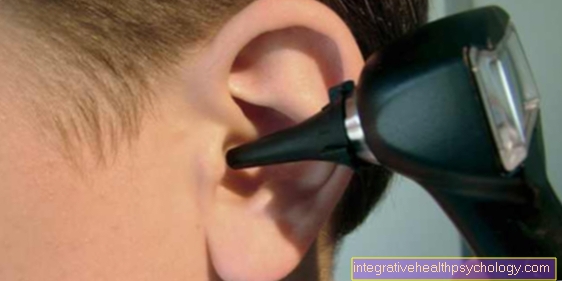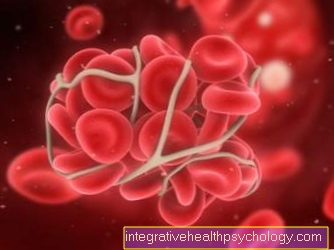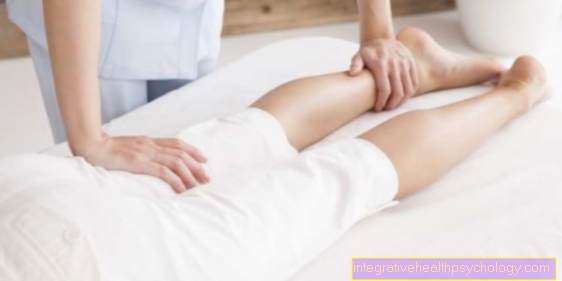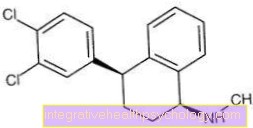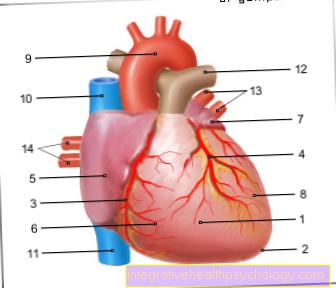Therapy of impingement syndrome
introduction
There are various options, both conservative and operative, to treat an impingement syndrome. The therapy is always based on the individual disease status.
However, conservative therapy is usually started. This means that one tries to reduce the symptoms and promote the healing process by means of physiotherapy, osteopathy, medication etc. Only when these methods fail is surgical treatment considered.

Physiotherapy
In impingement, manual therapy and humeral head centering exercises are used on the one hand.
With the help of manual therapy, the therapist can identify the existing movement disorders of the shoulder and treat them using certain techniques. Since impingement of the shoulder results in restricted mobility, the physiotherapist tries to expand the range of motion of the shoulder again by means of manual therapy.
The patient does not actively move the shoulder because the shoulder joint is moved by the therapist. In addition, the muscles of the shoulder, which are often tense during impingement, can be loosened by the physiotherapist through massage, heat therapy or electrotherapy.
Once the mobility of the joint has been restored, the humerus centering is continued. The shoulder joint or the humeral head (upper end of the humerus) is held in place by the so-called rotator cuff (shoulder muscles). If the muscles are too weak, the humeral head can slip or not sit properly in the socket, pinching structures and causing impingement. Muscles that pull the humeral head down, such as the latissimus dorsi muscle, should also be strengthened.
The muscles are strengthened, for example, by means of weights or are trained using equipment. In addition to strengthening the shoulder muscles, stretching exercises should also be performed. During physiotherapy, it can be decided which exercises are suitable.
Read about this too Impingement syndrome of the shoulder from a physiotherapeutic point of view
The exercises
The exercises against impingement serve to strengthen the rotator cuff and the latissimus dorsi muscle.
The rotator cuff is trained by means of internal and external rotation training and the latissimus dorsi with so-called "lat pulls".
To do this, various pulling exercises are carried out with a weight train or an attached rubber band. Which exercise is suitable and what the correct execution looks like should be discussed with the physiotherapist.
It is important that these exercises are not performed with pain. You should also consider sufficient stretching of the shoulder joints afterwards.
Read more about the topic here: Physiotherapy for an impingement syndrome.
Appointment with a shoulder specialist

I would be happy to advise you!
Who am I?
My name is Carmen Heinz. I am a specialist in orthopedics and trauma surgery in the specialist team of .
The shoulder joint is one of the most complicated joints in the human body.
The treatment of the shoulder (rotator cuff, impingement syndrome, calcified shoulder (tendinosis calcarea, biceps tendon, etc.) therefore requires a lot of experience.
I treat a wide variety of shoulder diseases in a conservative way.
The aim of any therapy is treatment with full recovery without surgery.
Which therapy achieves the best results in the long term can only be determined after looking at all of the information (Examination, X-ray, ultrasound, MRI, etc.) be assessed.
You can find me in:
- - your orthopedic surgeon
14
Directly to the online appointment arrangement
Unfortunately, it is currently only possible to make an appointment with private health insurers. I hope for your understanding!
You can find more information about myself at Carmen Heinz.
Drug therapy
Pain-relieving drugs are used as drug therapy, which have an anti-inflammatory and decongestant effect at the same time.
These include the so-called NSAIDs (non-steroidal anti-inflammatory drugs) such as diclofenac, ibuprofen or celecoxib. The drugs are taken as tablets.
Which medication works best has to be tested. In addition, it should be ensured that the maximum daily dose is not exceeded and that the medication is not taken for too long, as these attack the gastric mucosa. You may also need to take a tablet to protect the stomach, such as proton pump inhibitors.
If the painkillers don't work, the doctor can inject cortisone and local anesthetics directly into the shoulder joint.
Find out more about the topic here: The cortisone syringe.
Cortisone
Cortisone is used in impingement syndrome when other pain relievers have failed.
For this, a mixture of cortisone and local anesthetic is injected directly into the inflamed joint. The cortisone counteracts the inflammatory reaction and swelling locally and the local anesthetic has a pain-relieving effect. The advantage of injection is that a reduction in pain can be achieved quickly. The freedom from pain, however, only lasts temporarily, so that the cortisone must be injected at intervals over several weeks until a lasting relief of the symptoms can be achieved.
In addition, the injections should always be done in combination with physiotherapy treatment in order to support the healing process and prevent recurrence of diseases in the shoulder joint.
The disadvantage is that a cortisone injection can lead to tendon degeneration of the muscles and thus to further problems.
Read more about here the effects of cortisone.
Alternative therapy options
The osteopathy
In osteopathy, too, diagnosis and therapy are carried out manually. Therapy in osteopathy is intended to support the body's ability to heal itself.
The practitioner tries to find the cause of the impingement by taking an anamnesis and examining the shoulder or the surrounding structures and to treat it.
In osteopathy, not only the shoulder is treated, but also the spine or the ribs, which can cause a shoulder joint misalignment. Depending on the cause, movement-promoting techniques are then used to support the body's self-healing powers by means of osteopathy.
Find out more about the topic here: Osteopathy.
The shock wave therapy
Shock wave therapy involves high-energy sound waves that are applied to the shoulder from the outside. These shock waves are intended to loosen or reduce calcifications.
Since the impingement is often caused by a calcified tendon of the supraspinatus muscle, shock wave therapy is intended to treat this calcification by stimulating the blood circulation and metabolism in this area.
Shock wave therapy is often chosen when other treatments are unsuccessful and surgery is to be postponed. The advantage of shock wave therapy is that it does not damage surrounding structures such as skin, muscles and bones.
The electro therapy
Diadynamic currents are stimulation currents with direct and impulse currents. A distinction is made in this area between five different current qualities that can be used individually or in combination
With regard to subacute or chronic stages of the impingement syndrome, attempts are made to achieve an analgesic effect or muscle toning by means of these diadynamic currents. The muscles should be loosened in this way.
More information on the topic Electrotherapy you'll find here.
Acupuncture
Acupuncture shows good results for shoulder problems. On the one hand, it can serve as an alternative if other therapy options fail. On the other hand, it can also be used to support other therapies in order to alleviate shoulder pain.
Acupuncture points are selected on the shoulder (so-called near points), removed from the shoulder, such as on the hands or even on the feet (so-called far points) or on the ear (so-called ear acupuncture).
Which points are selected depends on the respective complaints and what the anamnesis and the examination revealed.
Homeopathy
Various homeopathic remedies can be taken to support the improvement of symptoms and healing.
Arnica can help reduce the pain, inflammation and swelling in the shoulder. Bryonia can also be taken against the inflammation in the shoulder joint. Rhus toxicodendron is used for diseases of the muscles, tendons and joints and can also improve the symptoms of impingement.
Ruta globules can also help alleviate shoulder pain and aid healing.
The home remedies
On the one hand, gentle massages e.g. the tendons or the neck help to reduce pain and swelling in the shoulder. If possible, the massage oil can be warmed up so that the muscles can relax properly. Care should be taken to ensure that the massage is not performed on the painful areas of the shoulder.
Ginger tea can also help counteract inflammation in the shoulder joint. A cup of tea should be drunk two to three times a day.
A homemade paste of turmeric and oil (e.g. coconut oil) can help relieve pain, inflammation and swelling. The paste is applied directly to the painful shoulder. Once the paste has dried, it can be rinsed off with warm water.
When do you need an operation?
An operation for impingement is necessary if the so-called conservative therapies (medicinal, physiotherapeutic and other treatment methods) are not successful and the pain persists.
The time until one describes the conservative therapy attempts as "unsuccessful" is usually between 3-4 months.
The surgical method can then be minimally invasive - i.e. with small incisions - arthroscopically or rarely open. Which surgical method is chosen depends on the existing damage in the shoulder. In general, however, due to the spontaneous healing of the impingement, one is often very hesitant to treat it surgically.
Risks of the operation
In general, there are seldom complications during surgery on the shoulder. Since the procedure is usually performed under general anesthesia, there are risks of anesthesia such as nausea, vomiting or allergic reactions to medication. However, these are also relatively rare and depend on the patient's previous illnesses.
It can also lead to wound healing disorders and infections at the cuts or in the shoulder. However, since the cleanliness of the devices is very important, infections rarely occur.
There can also be injuries to vessels with subsequent bleeding or damage to nerves with permanent sensory disturbances or failures.
More information on the topic Impingement syndrome surgery can be read here.



















